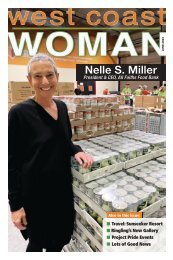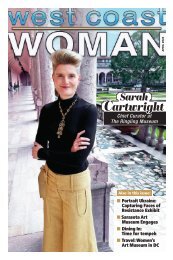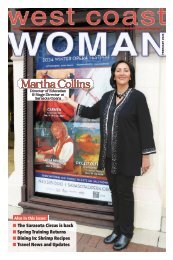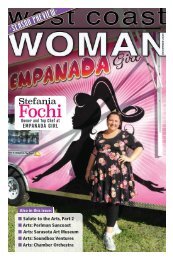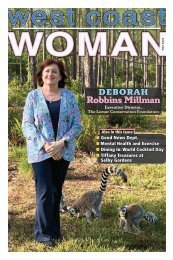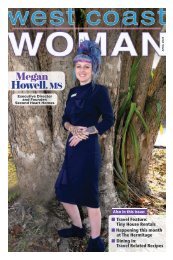wcw 3-23 all pages
It's our 35th Anniversary this month and we've got another great issue full of interesting articles plus our WCW, Angie Stringer, CEO and President of Girls Inc. of Sarasota. Learn about Mangroves, a Venice urban forest, the UNIFEM film festival, concerts, calendar of events recipes and more...enjoy!
It's our 35th Anniversary this month and we've got another great issue full of interesting articles plus our WCW, Angie Stringer, CEO and President of Girls Inc. of Sarasota. Learn about Mangroves, a Venice urban forest, the UNIFEM film festival, concerts, calendar of events recipes and more...enjoy!
You also want an ePaper? Increase the reach of your titles
YUMPU automatically turns print PDFs into web optimized ePapers that Google loves.
feature<br />
Why Mangroves Matter<br />
EcoWalks Guided Tours show the many ways<br />
What I noticed<br />
first was the contrast<br />
from driving<br />
on I-75 heading<br />
south—what is referred<br />
to as a “moving<br />
parking lot”—to a gradual drop<br />
off in congestion to a quieter and<br />
less frenetic drive ending at peaceful<br />
and tranquil Lemon Bay Park.<br />
Approaching the park, which sits<br />
astride Lemon Bay, is a step back in<br />
time to the Florida of the ‘60s with<br />
shell roads and sm<strong>all</strong> ranch houses.<br />
Once inside the park, you’ll find<br />
classrooms and an information center.<br />
It’s here you’ll also meet your<br />
guide for EcoWalks: Mangroves, a<br />
two-hour walk that is mostly on the<br />
water’s edge and surrounded by<br />
mangroves. The tours are offered<br />
by University of Florida/IFAS Extension<br />
Sarasota County and Sarasota<br />
County Parks, Recreation, and Natural<br />
Resources.<br />
“Mangroves are tropical plants that<br />
are adapted to loose, wet soils, salt<br />
water and being periodic<strong>all</strong>y submerged<br />
by tides,” according to the<br />
Florida Department of Environmental<br />
Protection, which also describes<br />
what we begin to see on our walk.<br />
Mangroves exist around the world,<br />
but there are three species that are<br />
native to Florida: red mangrove (Rhizophora<br />
mangle), black mangrove<br />
(Avicennia germinans) and white<br />
mangrove (Laguncularia racemosa)<br />
which our guide, Dr. Armando<br />
Ubeda, a county extension agent,<br />
showed us how to differentiate.<br />
Along the way, he began to explain<br />
how mangroves are a vital part of the<br />
greater ecosystem in Florida.<br />
Mangroves can be 60-80 feet t<strong>all</strong><br />
which is surprising since we don’t<br />
see them that way. Why? Because<br />
what we see are mangroves that are often<br />
severely cut back. Regulations now<br />
set specific limits for trimming or removal<br />
of mangroves on private property<br />
—for the most part. But if their full value<br />
to the ecosystem were understood, they<br />
would never be cut back. And that’s<br />
what you’ll learn by taking this EcoWalk.<br />
In fact, Dr. Ubeda explains they they’re<br />
the best form of storm protection because<br />
they absorb energy. During<br />
storms and hurricanes they slow down<br />
water, helping to hold on to soil while<br />
lessening erosion. But there’s so much<br />
more. They produce oxygen. Birds nest<br />
and seek shelter in them. They capture<br />
carbon dioxide. He also told us that 80<br />
per cent of seafood comes from mangroves<br />
having started as sm<strong>all</strong> fish.<br />
Those fish grow and find safety among<br />
mangroves until they are large enough<br />
to move out into open water thus contributing<br />
to keeping fish populations up.<br />
On a bright and cool Saturday morning,<br />
the EcoWalk begins.<br />
A tunnel of mangroves<br />
showing how t<strong>all</strong> they can grow.<br />
You can actu<strong>all</strong>y walk through mangroves<br />
like a forest which is what we did.<br />
The red mangrove is easily identified by<br />
its tangled, reddish roots c<strong>all</strong>ed “proproots.”<br />
These roots have earned mangroves<br />
the title of “walking trees.” By the<br />
end of the walk you’ll be able to differentiate<br />
which type of mangrove you’re<br />
seeing, and what makes it unique.<br />
All kinds of animals have been spotted<br />
in the park from gopher tortoises who<br />
burrow in the sand to bats who reside<br />
in their own bat house before heading<br />
out at night. Bats love mosquitoes BTW.<br />
You may also see iguanas but they’re<br />
an invasive species. Also seen are raccoons,<br />
coyotes, nonvenomous snakes<br />
and crabs.<br />
According to Dr. Katherine Clements,<br />
Ecology and Natural Resources Educator,<br />
who coordinates the EcoWalks,<br />
“We offer these walks specific<strong>all</strong>y on<br />
unique and often environment<strong>all</strong>y sensitive<br />
Sarasota County park and preserve<br />
lands which have been in part purchased<br />
Our guide for the walk is Dr. Armando Ubeda,<br />
a county extension agent,<br />
who explains the value of the mangroves.<br />
A red mangrove,<br />
identified by its tangled,<br />
reddish roots c<strong>all</strong>ed prop-roots.<br />
through funding from Florida Communities<br />
Trust grants. The FCT grants often<br />
require an educational component, and<br />
we work with County Park staff to determine<br />
topics and sites with the most<br />
need. We offer about 30 EcoWalks to the<br />
public at various sites with a variety of<br />
themes throughout the year.”<br />
There’s also something to be said<br />
about being with other people—and<br />
not online. People were talking to each<br />
other, sharing stories and asking where<br />
you’re from.<br />
EcoWalks fill up fast, so sign up right<br />
away. Register for EcoWalks here:<br />
www.eventbrite.com/cc/ecowalks.<br />
STORY and IMAGES: Louise Bruderle<br />
ABOUT LEMON BAY<br />
Lemon Bay is a long, narrow and sh<strong>all</strong>ow<br />
body of water covering 8,000 acres<br />
in Charlotte County, and Sarasota County.<br />
It is protected as the Lemon Bay<br />
Aquatic Preserve, designated in 1986. It<br />
is one of five Charlotte Harbor Aquatic<br />
Preserves. The bay is fed by one Gulf<br />
pass, Stump Pass, and seven tributaries<br />
and includes areas of mangrove, marsh<br />
grass, and seagrass. It provides habitat<br />
for bird, invertebrate and fish species<br />
and offers fishing, kayaking, birding,<br />
wading and beachcombing.<br />
ABOUT<br />
LEMON BAY<br />
PARK<br />
The Lemon Bay<br />
Park and Environmental<br />
Center is<br />
a 210-acre natural<br />
county park<br />
in Englewood. It<br />
includes black<br />
mangrove forest,<br />
mangrove fringe<br />
along the shoreline,<br />
and pine and<br />
scrubby flatwoods.<br />
Educational classes,<br />
guided nature<br />
and bird walks are<br />
offered at the site.<br />
The park has 1.7<br />
miles of shoreline on the Lemon Bay<br />
Aquatic Preserve. The park includes a<br />
butterfly garden, canoe/ kayak launch,<br />
and interpretive nature trail. The park is<br />
located at 570 Bay Park Boulevard.<br />
Educational classes, guided nature<br />
and bird walks and a variety of other<br />
nature-based programs are offered<br />
throughout the year.<br />
Upcoming EcoWalks:<br />
■ EcoWalk: Mangroves—March<br />
28, 8:30-10:30 a.m. (this is the same<br />
walk as described above)<br />
Lemon Bay Park, 570 Bay Park Blvd.,<br />
Englewood<br />
■ EcoWalk: Family Sunset Adventures—March<br />
31, 7-8:15 p.m.<br />
Explore the mysteries of the setting<br />
sun for an engaging family-friendly<br />
moonlight walk.<br />
Lemon Bay Park, 570 Bay Park Blvd.,<br />
Englewood<br />
■ EcoWalk: Meditation in the Parks -<br />
Red Bug Slough—April 12, 9-10 a.m.<br />
Also offered on May 22. 9-10 a.m.<br />
This offers an exploration of finding<br />
peace within nature along a mostly<br />
silent walk.<br />
Red Bug Slough Preserve,<br />
5200 South Beneva Road, Sarasota<br />
■ EcoWalk: Unique Preserves of<br />
Sarasota County - Curry Creek East<br />
—April 18, 9-11 a.m.<br />
Learn more about unique Florida<br />
ecosystems.<br />
Curry Creek Preserve East,<br />
1500 Pinebrook Road, Venice<br />
■ EcoWalk: Unique Preserves of<br />
Sarasota County - Sleeping Turtles<br />
South—May 9, 9-11 a.m.<br />
Learn more about unique Florida<br />
ecosystems.<br />
Sleeping Turtles Preserve South,<br />
2800 N. River Road, Venice<br />
University of Florida/IFAS<br />
Extension Sarasota County<br />
6700 Clark Road, Sarasota.<br />
Information:<br />
sarasota.ifas.ufl.edu and scgov.net<br />
MARCH 20<strong>23</strong> WEST COAST WOMAN 27



